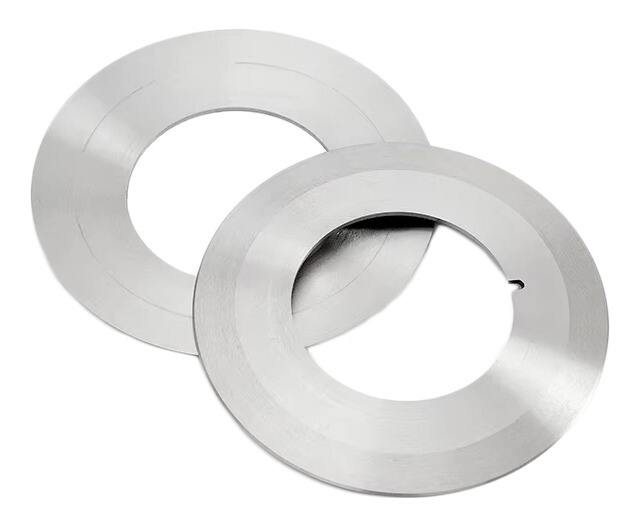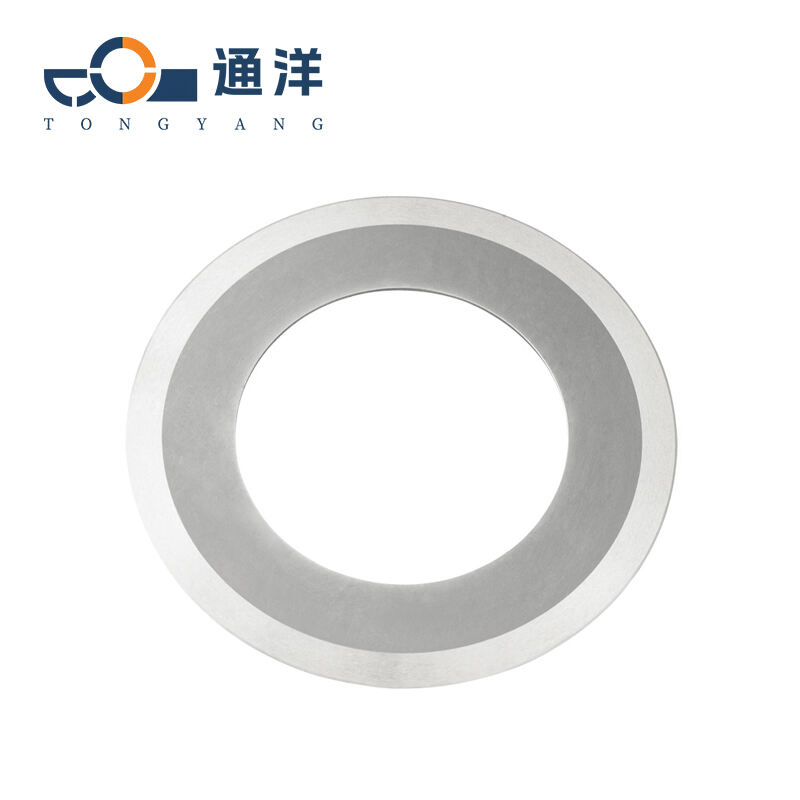Which Round Blade Material Lasts Longest in Cardboard
When cutting cardboard, the durability of your round blade depends heavily on its material. Cardboard—with its fibrous structure, glue layers, and occasional embedded debris—acts as an abrasive, wearing down blade edges over time. Choosing the right material for your round blade can significantly extend its service life, reducing replacement costs and downtime. This guide compares common round blade materials, their performance in cardboard cutting, and which one lasts longest under regular use.
Key Factors for Round Blade Durability in Cardboard
To understand which material lasts longest, it’s important to know what makes a round blade durable in cardboard cutting. Three key factors determine performance:
- Wear Resistance: The ability to resist abrasion from cardboard fibers and glue. A wear-resistant round blade maintains its sharp edge longer, even with frequent use.
- Hardness: Measured on the Rockwell scale (HRC), hardness indicates how well a blade resists deformation. Harder blades hold their edge better but may be more brittle.
- Toughness: The ability to withstand impacts, such as hitting staples or small debris in cardboard. Tough blades resist chipping or breaking, even when encountering unexpected obstacles.
Cardboard cutting demands a balance of these traits. A blade that’s too hard may chip; one that’s too soft will dull quickly. The best round blade material for cardboard combines high wear resistance with enough toughness to handle real-world conditions.
Common Round Blade Materials for Cardboard Cutting
Several materials are used to make round blades for cardboard, each with unique properties that affect durability.
High-Carbon Steel Round Blades
High-carbon steel is a traditional blade material, containing 0.6–1.0% carbon for increased hardness. It’s widely used in general-purpose cutting tools, including round blades for cardboard.
- Hardness and Wear Resistance: High-carbon steel has a hardness of 55–60 HRC, providing good wear resistance for light to moderate cardboard cutting. It sharpens easily, making it a popular choice for low-volume use.
- Toughness: It offers moderate toughness, resisting chipping in normal use but may crack if exposed to frequent impacts (like staples in cardboard).
- Performance in Cardboard: High-carbon steel round blades work well for occasional or home use, cutting thin to medium cardboard effectively. However, their wear resistance is lower than other materials, so they dull faster with heavy use—requiring more frequent sharpening or replacement.
- Lifespan Estimate: For light use (a few hours weekly), a high-carbon steel round blade may last 1–3 months. For heavy use (daily, high-volume cutting), lifespan drops to 2–4 weeks.
Stainless Steel Round Blades
Stainless steel round blades add chromium (10–30%) to resist corrosion, making them ideal for damp or food-related environments, but they also perform in cardboard cutting.
- Hardness and Wear Resistance: Most stainless steel blades have a hardness of 50–55 HRC, slightly lower than high-carbon steel. This means they dull faster in abrasive cardboard, especially when cutting thick or coated cardboard (like corrugated boxes with waxed surfaces).
- Toughness: Stainless steel is more ductile than high-carbon steel, offering better impact resistance. It’s less likely to chip when hitting staples or debris.
- Performance in Cardboard: Stainless steel round blades are a good choice if corrosion is a concern (e.g., in humid warehouses), but their lower wear resistance makes them less durable than high-carbon steel for heavy cardboard cutting.
- Lifespan Estimate: For light use, 1–2 months; for heavy use, 1–3 weeks. They often need sharpening more frequently than high-carbon steel.

Carbide-Tipped Round Blades
Carbide-tipped round blades have a steel body with a layer of tungsten carbide (a super-hard material) bonded to the cutting edge. Tungsten carbide is one of the hardest materials used in blade manufacturing.
- Hardness and Wear Resistance: Tungsten carbide has a hardness of 80–90 HRC, far higher than steel. This extreme hardness makes carbide-tipped round blades highly resistant to abrasion from cardboard fibers and glue. They maintain their sharp edge even when cutting thick, coated, or reinforced cardboard.
- Toughness: The steel body provides toughness, while the carbide tip adds wear resistance. However, carbide is brittle—if the blade hits a large staple or is dropped, the carbide tip may chip. Proper handling minimizes this risk.
- Performance in Cardboard: Carbide-tipped round blades excel in high-volume, heavy-duty cardboard cutting. They handle corrugated cardboard, cardboard tubes, and even cardboard with embedded materials (like tape or thin plastic layers) without rapid dulling.
- Lifespan Estimate: For heavy daily use, carbide-tipped round blades can last 6–12 months, and sometimes longer with proper maintenance. This is 5–10 times longer than steel blades under the same conditions.
Ceramic-Coated Round Blades
Ceramic-coated round blades have a steel core with a thin ceramic layer (usually aluminum oxide or zirconia) applied to the cutting edge. The ceramic layer adds hardness and wear resistance.
- Hardness and Wear Resistance: Ceramic coatings have a hardness of 70–80 HRC, offering better wear resistance than steel but less than carbide. They reduce friction, which can slow wear in cardboard cutting.
- Toughness: The steel core provides toughness, but the ceramic coating is brittle. It can chip if the blade hits hard debris, and the coating may wear thin over time with heavy use.
- Performance in Cardboard: Ceramic-coated round blades work well for medium-volume cutting of standard cardboard. They last longer than steel blades but not as long as carbide-tipped ones. The ceramic layer also reduces material buildup, keeping the blade cleaner during use.
- Lifespan Estimate: For medium use, 2–6 months. Heavy use may reduce lifespan to 1–3 months as the coating wears away.
Why Carbide-Tipped Round Blades Last Longest in Cardboard
Carbide-tipped round blades outlast other materials in cardboard cutting for several reasons:
- Extreme Hardness: Tungsten carbide’s high hardness resists the abrasive action of cardboard fibers, which quickly wear down steel blades. Even after cutting thousands of cardboard sheets, the carbide edge remains sharp.
- Resistance to Glue and Coatings: Cardboard often contains adhesives or wax coatings that can gum up steel blades, accelerating dullness. Carbide’s smooth surface resists buildup, maintaining cutting efficiency longer.
- Durability in Heavy Use: For industrial settings—like packaging plants, warehouses, or shipping facilities where round blades cut cardboard all day—carbide-tipped blades maintain performance for months, reducing the need for frequent replacements.
While carbide-tipped blades have a higher upfront cost than steel blades, their extended lifespan makes them more cost-effective in the long run, especially for high-volume operations.
Tips to Maximize Round Blade Lifespan in Cardboard
Regardless of material, proper care can extend a round blade’s life in cardboard cutting:
- Keep Blades Sharp: Even carbide-tipped blades benefit from occasional sharpening (by a professional) to remove micro-chips and maintain their edge.
- Avoid Debris: Clear cardboard of staples, nails, or rocks before cutting to prevent chipping, especially for carbide or ceramic blades.
- Use the Right Speed: Match the blade speed to the cardboard thickness. Too slow, and the blade drags; too fast, and heat builds up, damaging the edge.
- Clean Regularly: Wipe the blade after use to remove glue or fiber buildup, which can act as an abrasive over time.
- Store Properly: Keep blades in a dry, protected case when not in use to prevent corrosion (for steel blades) or chipping (for carbide/ceramic).
FAQ
Are carbide-tipped round blades worth the higher cost for cardboard cutting?
Yes, for heavy or regular use. While they cost more upfront, their lifespan is 5–10 times longer than steel blades, saving money on replacements and reducing downtime.
Can high-carbon steel blades be used for thick corrugated cardboard?
They can, but they will dull quickly. High-carbon steel is better for thin cardboard or low-volume use. For thick corrugated cardboard, carbide-tipped blades are better.
Do ceramic-coated blades last longer than stainless steel in cardboard?
Yes, ceramic-coated blades have better wear resistance than stainless steel, lasting 2–3 times longer in medium-volume cardboard cutting.
What causes a round blade to wear out quickly in cardboard?
Abrasion from cardboard fibers, glue buildup, hitting debris (like staples), and improper speed or pressure during cutting all accelerate wear.
How can I tell when a round blade needs replacement?
Signs include ragged cuts, increased effort to cut, frequent jams, or visible nicks/chips in the edge. Carbide-tipped blades may show wear as reduced cutting speed.
Table of Contents
- Which Round Blade Material Lasts Longest in Cardboard
- Key Factors for Round Blade Durability in Cardboard
- Common Round Blade Materials for Cardboard Cutting
- Why Carbide-Tipped Round Blades Last Longest in Cardboard
- Tips to Maximize Round Blade Lifespan in Cardboard
-
FAQ
- Are carbide-tipped round blades worth the higher cost for cardboard cutting?
- Can high-carbon steel blades be used for thick corrugated cardboard?
- Do ceramic-coated blades last longer than stainless steel in cardboard?
- What causes a round blade to wear out quickly in cardboard?
- How can I tell when a round blade needs replacement?

